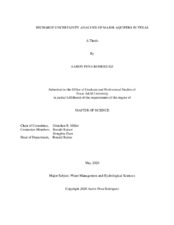| dc.description.abstract | While the reduction of the groundwater available volume in the state of Texas of urban, agricultural, and industrial use has been dealt with in different ways, the first step is to assess the current and future behavior of the aquifers that supply it. For this the Texas Water Development Board created the Groundwater Availability models. This paper studies the recharge data used to build them and how the sensitivity to changes in recharge of each aquifer can affect the available groundwater statewide to point to interest aquifers that need a more in-depth recharge analysis. The reported recharge in the models was variated from 50% to 150% to determine changes in head, stored volume, and overall baseflow. The normalized variations where then compared to select the most and least recharge sensitive aquifers to perform a recharge surge reflecting that of hurricane Harvey (1000% normal recharge) in the Gulf Coast Center (Houston, Texas) to determine the behavior when subjected to atypical recharge events. Given the great geohydrological variability, not only inside the aquifers, but between the analyzed aquifers, the changes in head, volume, and baseflow do not only follow the greatest increase in recharge. The Hueco Mesilla Bolson aquifer experienced the least absolute change in mean head (0.0003% of normal head), paired with the lowest absolute change in recharge (0.004m1 y -1). However, the Edwards Balcones Fault Zone Springs (near San Antonio, Texas) experiences the largest absolute change in recharge (0.370m-1 y -1), but the Gulf Coast North experienced the largest absolute change in mean head (42% of normal head). While the differences in composition and size of the aquifers make a complete comparison difficult, the most sensitive aquifers, determined by the linear model to which head and stored volume were subjected to, were determined to be the Trinity North and the Edwards Trinity Plateau for respectively. These two can be the focus of subsequent and more localized studies to determine the feasibility of the recharge driven strategies to increase the groundwater availability of Texas. | en |


